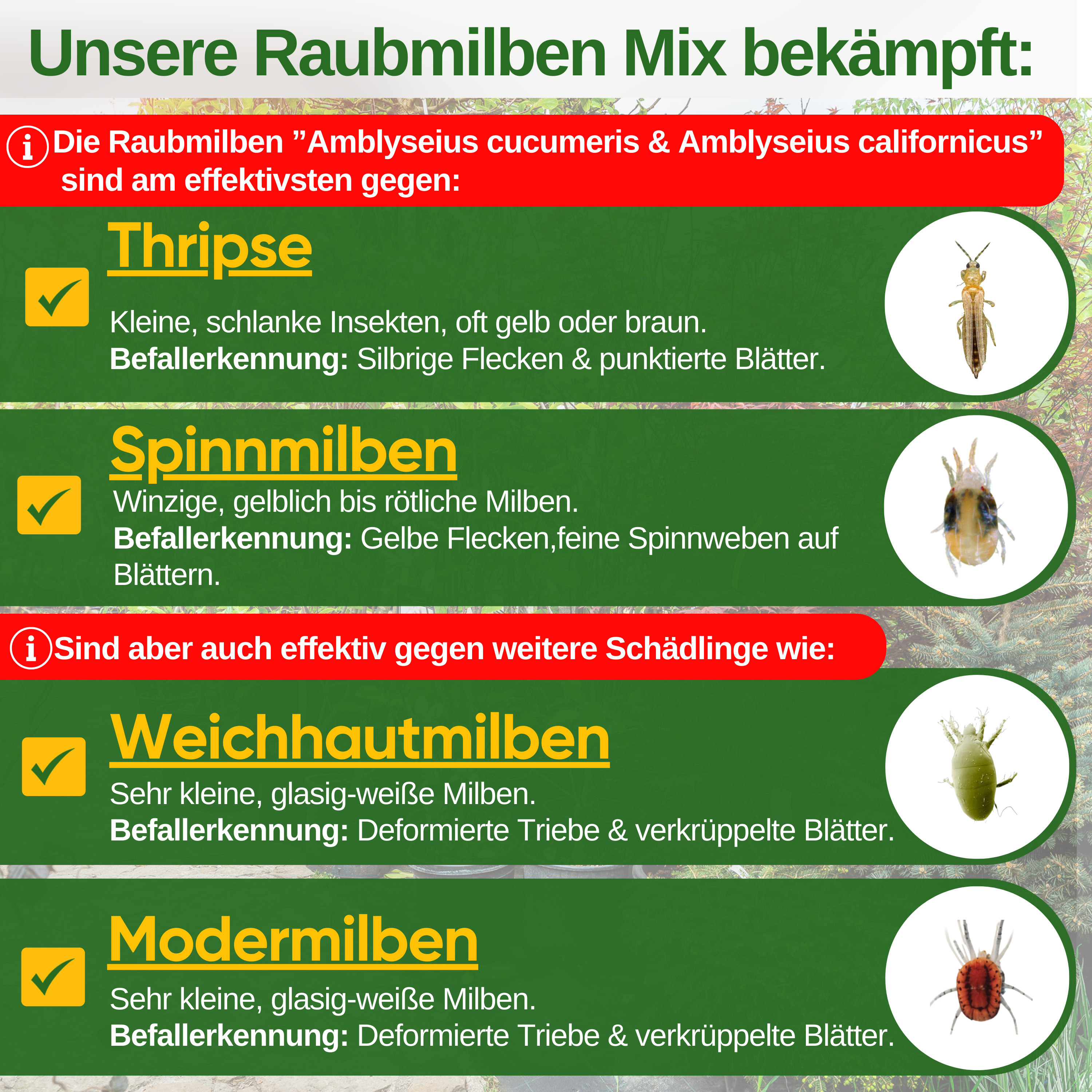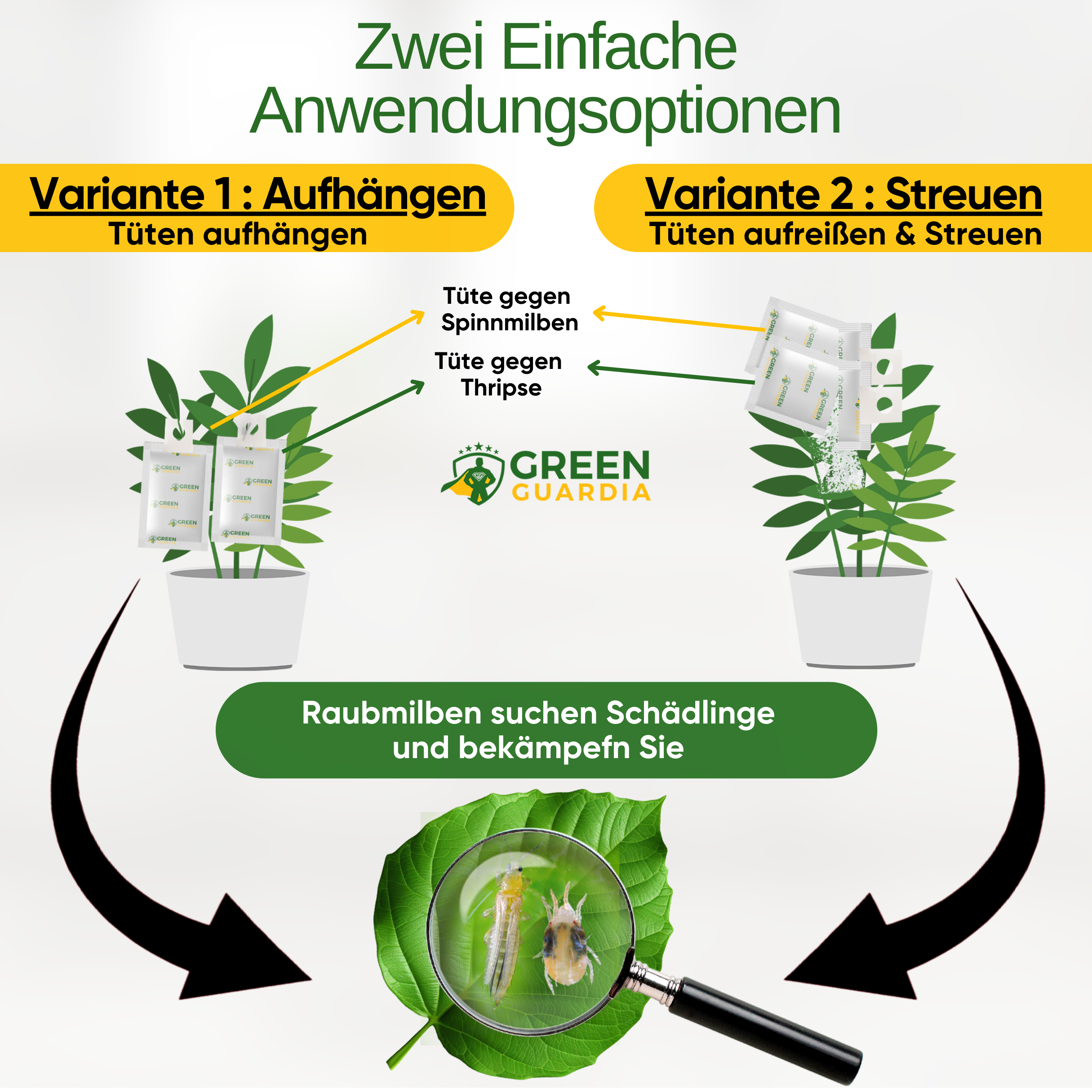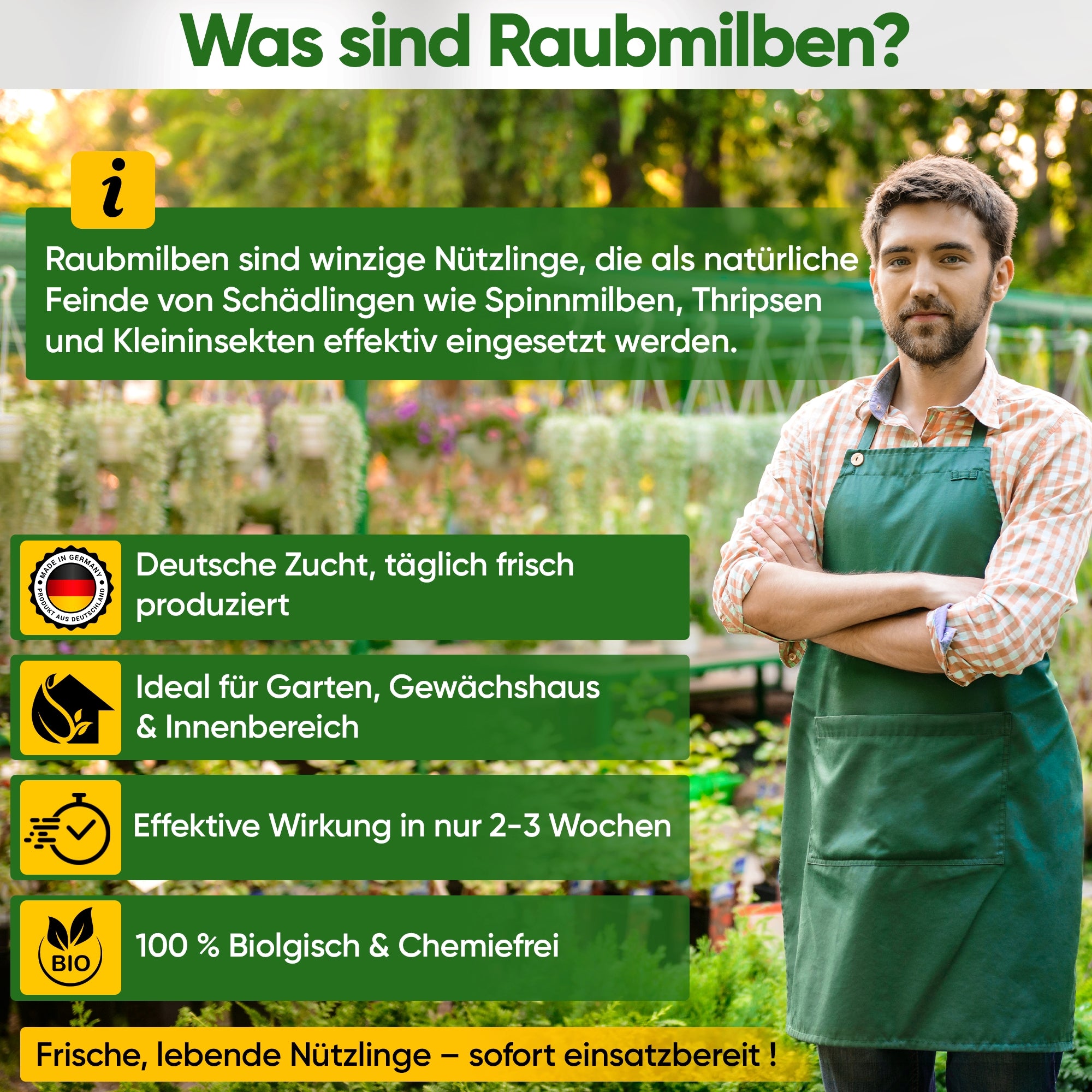
Number of bags














Predatory mite mix against thrips & spider mites for hanging or scattering
-
100% natural help against spider mite infestation
-
From German breeding – delivered quickly
-
Completely chemical-free – no residues
-
Discreet, effective & biologically sustainable
-
Safe for children and pets
Number of bags
In stock - in 2-4 working days with you
Was unsere Kund*innen sagen
-
Wirksamkeit
kaum Wirkung teilweise wirksam sehr wirksam -
Anwendung
kompliziert etwas Aufwand kinderleicht -
Lieferqualität
schlechter Zustand ok top Qualität
Choose options
-
100% natural help against spider mite infestation
-
From German breeding – delivered quickly
-
Completely chemical-free – no residues
-
Discreet, effective & biologically sustainable
-
Safe for children and pets
Number of bags
In stock - in 2-4 working days with you
Was unsere Kund*innen sagen
-
Wirksamkeit
kaum Wirkung teilweise wirksam sehr wirksam -
Anwendung
kompliziert etwas Aufwand kinderleicht -
Lieferqualität
schlechter Zustand ok top Qualität
-
100% natural help against spider mite infestation
-
From German breeding – delivered quickly
-
Completely chemical-free – no residues
-
Discreet, effective & biologically sustainable
-
Safe for children and pets
Number of bags
In stock - in 2-4 working days with you
Was unsere Kund*innen sagen
-
Wirksamkeit
kaum Wirkung teilweise wirksam sehr wirksam -
Anwendung
kompliziert etwas Aufwand kinderleicht -
Lieferqualität
schlechter Zustand ok top Qualität
Predatory mite mix against spider mites & thrips – natural & effective
GREEN GUARDIA predatory mites are tiny but highly effective beneficial insects for the biological control of thrips and spider mites – completely without chemicals. These active predators roam leaves, flowers, and substrates to specifically locate and destroy larvae, eggs, and adult pests.
Whether as scattered material or in practical bags for hanging – the predatory mite mix adapts flexibly to your needs and provides natural pest protection in the garden, greenhouse or indoors .
Areas of application for predatory mites
- Houseplants & ornamental plants: Perfect for indoor spaces and low-light locations.
- Greenhouse & raised beds: Sustainable protection for sensitive crops.
- Vegetable & herb garden: Gentle on edible plants, bee-friendly.
- Indoor grow & balcony plants: Invisible, silent and effective – without residue.
Application & Tips
- Application: Sprinkle directly onto the plant or hang sachets on branches.
- Optimal temperature: Predatory mites develop best at 18 °C and above.
- Humidity: 60–80% humidity increases the success rate.
- Avoid pesticides: Avoid chemicals to protect beneficial insects.
- Storage: Use as fresh as possible. Can be stored for 1–2 days at 8–12°C.
🌿 Conclusion: The GREEN GUARDIA predatory mite mix is your sustainable solution against thrips and spider mites – effective, residue-free and safe for humans, animals and the environment.
Raubmilben gegen Spinnmilben & Thripse – natürlich & effektiv
Mit dem GREEN GUARDIA Raubmilben-Mix setzt du auf eine 100 % biologische Schädlingsbekämpfung für Haus, Garten oder Gewächshaus. Die natürlichen Nützlinge gehen gezielt gegen Spinnmilben und Thripse vor – ohne Chemie, Rückstände oder Nebenwirkungen.
Zwei Anwendungsformen – flexibel je nach Bedarf
- Hängetüten: Einfach an die Pflanze hängen – die Raubmilben verlassen die Tüte selbstständig und verteilen sich auf der Pflanze.
- Streuware: Den Beutelinhalt vorsichtig auf befallene Blätter oder direkt auf die Erde geben – ideal für größere Flächen oder gezielte Stellen.
Dosierungsempfehlung
- Bei akutem Befall: 1 Mix pro Pflanze oder etwa 3 m² Fläche.
- Zur Vorbeugung: 1 Mix für 2 Pflanzen oder ca. 6 m² Fläche.
Anwendungstipps für maximale Wirksamkeit
- Frühzeitig einsetzen: Bereits bei ersten Anzeichen von Spinnmilben oder Thripsen anwenden.
- Wiederholung bei starkem Befall: Anwendung nach 1–2 Wochen erneut durchführen.
- Kombination mit Gelbtafeln: Unterstützt die Schädlingsüberwachung und erhöht die Erfolgsrate.
- Optimale Bedingungen: Temperaturen ab 18 °C und eine mittlere Luftfeuchtigkeit sind ideal.
⚠️ Wichtig: Verzichte mindestens 6 Wochen vor und nach dem Einsatz auf synthetische Pflanzenschutzmittel – diese könnten die Raubmilben stark beeinträchtigen oder abtöten.
Was sind Thripse und Spinnmilben?
Thripse (Fransenflügler) und Spinnmilben gehören zu den häufigsten und hartnäckigsten Pflanzenschädlingen – sowohl im Gewächshaus, auf Balkonpflanzen, Zimmerpflanzen als auch im Garten.
Thripse sind kleine, längliche Insekten, die an Blättern, Blüten und Früchten saugen. Sie hinterlassen silbrige Flecken, braune Punkte und verzerrte Blätter. Häufig verstecken sie sich tief in Blüten oder Blattachseln.
Spinnmilben sind winzige, rötlich-gelbe Milben, die sich bevorzugt an der Blattunterseite aufhalten. Sie verursachen helle Sprenkel, Vergilbung und feine Gespinste, die sich zwischen Trieben und Blättern bilden.
Wie kann ich Thripse & Spinnmilben natürlich bekämpfen?
Die effektivste Methode zur biologischen Schädlingsbekämpfung ist der gezielte Einsatz von Raubmilben wie Amblyseius cucumeris, Amblyseius swirskii oder Phytoseiulus persimilis. Diese natürlichen Gegenspieler jagen die Schädlinge aktiv und regulieren den Befall nachhaltig – ganz ohne Chemie.
🌿 Tipp: Raubmilben sind am aktivsten bei Temperaturen ab 18 °C und einer erhöhten Luftfeuchtigkeit. Besprühe die Pflanzen regelmäßig, um optimale Bedingungen zu schaffen.
Wie kann ich einem Befall vorbeugen?
- Pflanzen regelmäßig kontrollieren: Achte auf silbrige Flecken, deformierte Blätter oder feine Gespinste.
- Luftfeuchtigkeit erhöhen: Besonders in Innenräumen – z. B. durch tägliches Besprühen oder Luftbefeuchter.
- Befallene Pflanzenteile entfernen: Frühzeitiges Eingreifen verhindert die Ausbreitung.
- Gelbtafeln verwenden: Unterstützen die Schädlingsüberwachung – besonders bei Thripsen.
- Nützlinge frühzeitig einsetzen: Raubmilben helfen sowohl zur Vorbeugung als auch zur akuten Bekämpfung.
⚠️ Wichtig: Vermeide chemische Pflanzenschutzmittel mindestens 6 Wochen vor und nach dem Einsatz von Raubmilben – sie können die Nützlinge schädigen oder abtöten.

German breeding
Beneficial insects from controlled German breeding – quality you can rely on

Expert advice
Application tips and support from our experts – targeted and effective.

Quick help
Our beneficial insects are ready for immediate use and provide targeted help in the event of acute infestation in the house or garden.

Natural & safe
Safe for everyday use – absolutely risk-free for children, pets and plants.
Wir lassen unsere Kund:innen sprechen.

Natural pest control
At GREEN GUARDIA you will find the right natural solution for every pest problem – completely without chemicals.
Whether parasitic wasps against moths, predatory mites against spider mites or nematodes against fungus gnats and snails – our beneficial insects provide reliable help in the house, garden or greenhouse.
As specialists in biological pest control, we stand for quality, innovation and sustainable impact – in harmony with nature, people and animals.

Expert advice – Personal & practical
Our expert advisors will support you with targeted application tips and many years of experience in natural pest control. Whether you have questions about application, combining different beneficial organisms, or selecting the right product – we'll help you quickly and competently.
FAQ Predatory mites
Do you have questions about our products, their use, or shipping? Here you'll find the most important answers at a glance. If anything remains unclear, please feel free to contact us!

Predatory mites are microscopic, beneficial arachnids that feed on pests such as thrips and spider mites. They actively hunt their prey and help regulate pest populations naturally—without the use of chemicals.
Depending on the application, Amblyseius cucumeris is commonly used against thrips and Phytoseiulus persimilis against spider mites. Both species are specialized for their target pests.
No. Predatory mites are completely harmless to humans, children, and pets. They are tiny, don't bite, and disappear as soon as there is no more prey.
Ideal for ornamental plants, houseplants, and vegetables such as cucumbers, peppers, tomatoes, and strawberries—both indoors and outdoors. They also provide effective support in greenhouses.
Yes, preventative use is especially useful for susceptible plants. Predatory mites settle and intervene immediately when the first pests appear.
Bags contain food and breeding material in which the predatory mites can survive for up to 15 days and then migrate peau a peau on their own. Loose material is intended for quick, immediate use—e.g., in the event of an acute infestation.
We usually ship live beneficial insects Monday to Thursday to ensure they arrive fresh and vital – delivery is usually within 1-3 business days.
The animals arrive in small bags or as scattered material in substrate—well packaged and protected from light. This packaging ensures optimal living conditions during transport.
Apply the predatory mites immediately upon receipt. If necessary, you can store them for 1–2 days at 8–10°C (46–50°F)—but apply them as quickly as possible.
Live beneficial insects are non-returnable. However, we're happy to help you with any problems.
No, shipping to packing stations is not possible for live beneficial insects. Please provide a home address where you can receive the shipment directly.
Yes, we also ship predatory mites abroad.
Hang bags directly onto the plant or sprinkle the substrate evenly over the affected parts. Avoid direct sunlight and check regularly.
As soon as you notice the first signs of thrips or spider mites, the sooner you react, the more effective the control will be.
In case of infestation, one bag or sprinkler is sufficient for approximately 1 plant or 10 m². For prevention, one bag is sufficient for 2 plants or approximately 20 m².
Depending on the severity of the infestation, a follow-up treatment may be necessary after 1–2 weeks. In many cases, one application is sufficient – preventatively, approximately every 4–6 weeks.
As long as they find pests, they remain active. When the food source dries up, they die or retreat – leaving no residue.
They prefer temperatures of approximately 18°C and above and high humidity (60–80%). In very dry, heated air, we recommend spraying the plants regularly.
In addition to the predatory mites, the bags also contain food, so the mites often have enough food and don't leave the bag immediately. This is completely normal and not a sign that they are inactive.
Our predatory mites can survive in the bags for up to 15 days – even at sub-zero temperatures.
The bags are already provided with small holes through which the predatory mites can easily escape. Simply hang the bags on the affected plants or near the infested areas. The predatory mites will set off on their own and find their target automatically.
Yes, in mild weather (over 15°C) you can also use them outdoors – for example, in flowerbeds, balcony plants, or raised beds.
Thrips are elongated, fast-moving insects that leave silvery feeding marks. Spider mites form fine webs, often on the undersides of leaves – yellow spots are a typical symptom.
No. Synthetic pesticides and many oils are harmful to predatory mites. Avoid using such products for two weeks before and four weeks after application.







